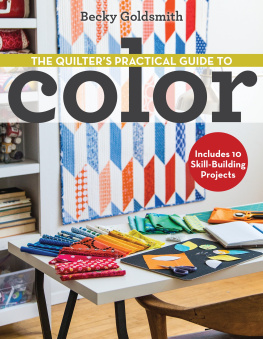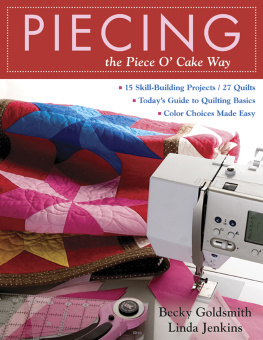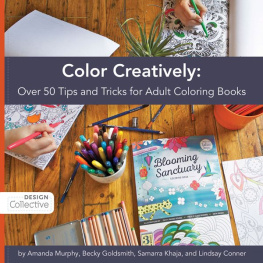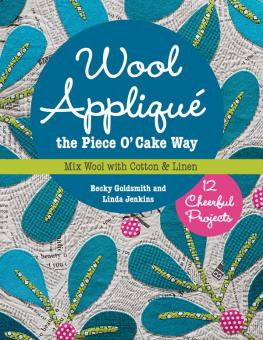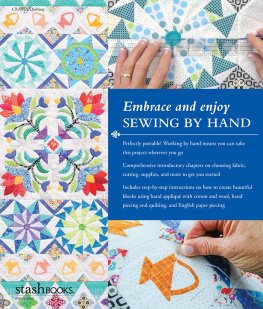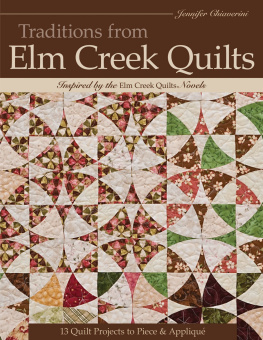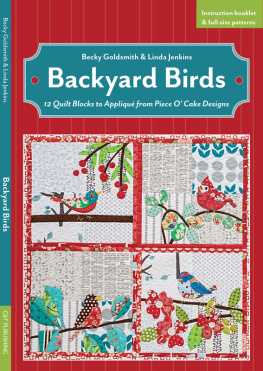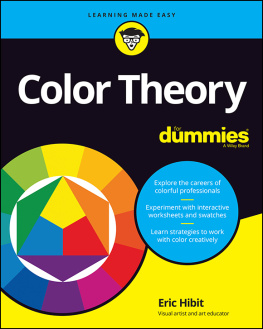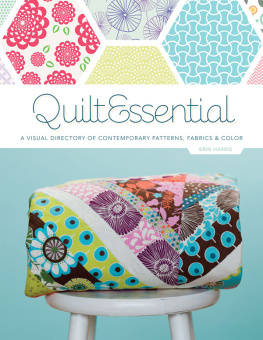PUBLISHER: Amy Marson
CREATIVE DIRECTOR: Gailen Runge
ART DIRECTOR: Kristy Zacharias
EDITORS: Lynn Koolish and Katie Van Amburg
TECHNICAL EDITORS: Debbie Rodgers and Gailen Runge
COVER/BOOK DESIGNER: April Mostek
PRODUCTION COORDINATOR: Freesia Pearson Blizard
PRODUCTION EDITOR: Alice Mace Nakanishi
ILLUSTRATORS: Becky Goldsmith and Kerry Graham
PHOTO ASSISTANT: Mary Peyton Peppo
INSTRUCTIONAL PHOTOGRAPHY by Diane Pedersen, unless otherwise noted
Published by C&T Publishing, Inc., P.O. Box 1456, Lafayette, CA 94549
DEDICATION
I dedicate this book to my family and to Linda and Paul Jenkins, who feel like family. They all do more than love methey put up with me.
My husband, Steve, deserves special attention. He takes such good care of me in a variety of ways. Rather than bringing home flowers and jewelry, he quietly makes sure that things happen. The car always has gas, the trash never overflows, and (more important) it is he who puts dinner on the table every night. Best of all, when he looks at me, I know that he loves me. I wouldnt be the same me without him beside me.
Guess what else? Steve also bastes my quilts, and after they are quilted, he hand stitches the bindings on my quilts. I do love this man.

Steve basting
ACKNOWLEDGMENTS
My heartfelt thanks go to Linda Jenkins, my friend and business partner, who for many years has patiently let me know both when I get it right and when I dont.
My daughter-in-law, Lorna, did so much to make this book possible. She has taken over much of the business end of pieceocake.com. Thanks to her dedication, I found the time to write this book and make the quilts.
I thank Roberta Horton for all she taught me through her books and in classesand especially for her book Scrap Quilts: The Art of Making Do. I learned so much from that book 30 years ago. Upon re-reading, I learned even more.
And I must thank Lynn Koolish, my editor. This book is better because she encouraged me to be even more practical than I thought I had already been. Her input, as always, is greatly appreciated.

Photos by Becky Goldsmith: A, B, DK Celia Goldsmith: C
introduction
We all love color. Playing with color is the happiest part of quilting. Even when the actual sewing might get tedious, color keeps us coming back for more.
The question is, if we love color, why do so many quilters say that color is scary?
I believe that what makes color scary to quilters is that it forces them to make a lasting decision.
You make color decisions all day long: What am I going to wear today? Which shoes go with this outfit? These choices, and many more each day, are made without much thought. More important, these choices are not permanent.
It feels harder to choose colors for a quilt because the color choices you make, once sewn, are final. You could make the quilt again, but who does that? Not me. No wonder you might feel a little scared by color.
Knowing why color scares you is half the battle. What comes next is figuring out how to move forward. This book is designed to help you do just that. It is a practical guide to color, with information that will benefit both beginning and experienced quilters alike. You will find many ideas in these pages that will make picking fabrics and colors for your quilts a happy experience.
THE BEST PART
It might make you gasp, but I dont make quilts to have quilts. My quilts are a lovely by-product of how I like to spend my time.
I love the challenge of designing new quilts. I revel in the vast combinations of color and pattern that are possible. I love the speediness of piecing during the daytime and the more meditative process of hand appliqu, which adds calm to my evenings. And even though writing instructions for a new book is not my favorite part of the process, I also embrace this challenge.
For me, the best part of every quilt is the time I spend picking out the colors. It can be frustrating and time consuming, but no matter how long it takes, this is my favorite part of making a quilt. Nothing replaces the satisfaction I get from seeing the result of my efforts on the design wall.
I hope that the time you spend selecting colors becomes your favorite part of quiltmaking too.
SPECIAL NOTE
Because this is a book about color, it does not include in-depth piecing or appliqu instructions (otherwise I would have had to cut back on the color information). If you have a preferred method for piecing or appliqu, please feel free to use it. If you are a beginner, I suggest you refer to The Best-Ever Appliqu Sampler by Linda Jenkins and me (from C&T Publishing), or any of our other appliqu books, for detailed appliqu instructions. For piecing, many good books are available, ranging from Start Quilting with Alex Anderson to The Practical Guide to Patchwork by Elizabeth Hartman (both from C&T Publishing), as well as many online resources.
the color wheel
Color wheels are pretty, and thats why we like looking at them. Beyond being pretty, however, a color wheel is a powerful tool that shows the relationships between colors. This is important because knowing how colors work together will help you use color better in your quilts.
Some people have spent their lives studying color theory. I am not one of them. I do have a degree in interior design, and what I learned in school has been valuablebut you do not need a college degree to be able to use a color wheel. I promise.

The color wheel
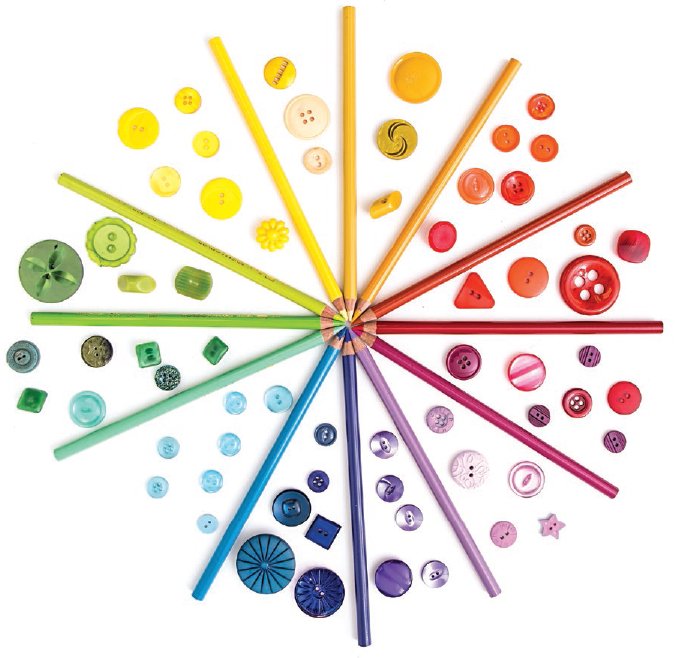
FOR MORE INFORMATION
Remember that this book is a practical guide to color. If you are interested, you can study more (much, much more) about color theory than I will tell you in this book. Where to start? Search the Internet for color theory and start clicking. Read books; a lot of them have been written on color. Refer also to for some of my favorite websites about color.
HOW THE COLOR WHEEL WORKS
It is easier to use a color wheel if you know why it is put together the way it is. The color wheels in this book are divided into twelve wedges that represent the twelve basic colors. There are more complex color wheels, with more colors and wedges, but for this book, a simple color wheel works best.
Besides being divided into wedges, the color wheel is also divided into five concentric rings. The colors are lighter in the rings toward the center and darker in the rings to the outside.
The True Colors
The middle ring on the color wheel is occupied by the truest color, or hue, in each wedge.
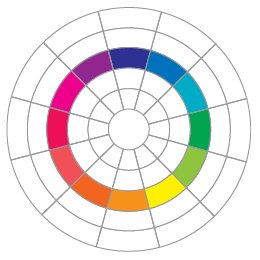
The truest colors occupy the middle ring.
Primary Colors
Primary colors are the only colors on the wheel that are not made from combining other colors. They are positioned an equal distance apart, separating the wheel into thirds.

Next page
